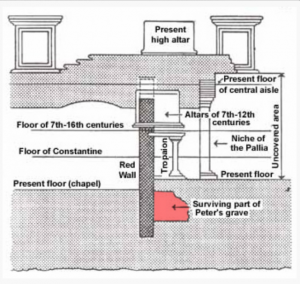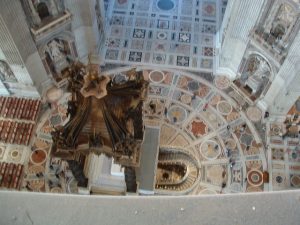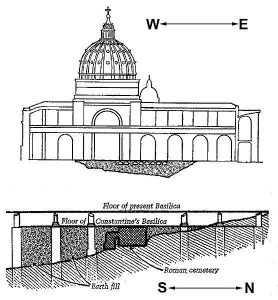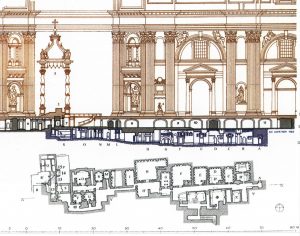St Peter and St Paul: 29 June 2025
Readings: Acts 12.1–11; Psalm 125; 2 Timothy 4.6–8, 17, 18; Matthew 16.13–19
May the words of my mouth
and the meditation of my heart
be acceptable in your sight, O Lord.
I wonder if you’ve ever been to Rome.
It’s somewhere I’ve been several times,
and one of the things I have done each trip
is visit the Vatican
and climb up the dome of the great basilica there.
It’s a bit of a slog,
some 500 steps to the top,
but when you get up there
you are rewarded
with some wonderful panoramic views across the city.
And you can also access the gallery
that runs around inside the dome.
From there
you get some really impressive views of the interior.
One thing you can see close up, for example,
is a Latin inscription
that runs full-circle around the dome.
In giant lettering it begins: “Tu es Petrus …”.
I’ll come back to these words in a moment.
– if you’re not too bothered about the height –
perhaps you can look straight down.
It’s a rather dizzying couple of hundred feet
but there beneath you
is the high altar,
with its great baldachino or canopy by Bernini.
And right in front of that altar
there’s a semi-circle of steps
leading further down,
down beneath the floor of the church.
Now these steps aren’t accessible to the public.
But if you could go down them,
and under the high altar,
you’d find yourself
standing among the remains
of an ancient Roman cemetery.
Because those steps take you down
to the site of the tomb of St Peter.
Of course, the church we see today
was completely rebuilt
some 4 or 500 years ago,
in the flamboyant baroque style.
But they rebuilt it
on exactly the same site
as the previous church,
with the high altar
in exactly the same place as before.

Section showing the various altars and floor levels and their relation to the tomb of St Peter. [Liturgical Arts Journal]
over a thousand years earlier,
in the 300s,
as soon as Christianity had been legalized.
It was built
– with considerable difficulty –
right on top of this ancient Roman cemetery;
and awkwardly,
on the side of a hill;
all carefully positioned
so that the high altar
was directly over
one particular tomb*.
And next to this cemetery
there had been an arena,
the Circus of Nero,
and that’s where many early Christians
had been put to death,
accused by Nero
of causing the great fire of Rome.
Peter himself was among those executed,
said to have been crucified
– crucified upside-down according to tradition.
Paul was a Roman citizen though,
so he was spared crucifixion
– he was beheaded
(and buried)
elsewhere in the city.
Other Christians were rounded up
and put to death in the arena:
torn apart by wild beasts,
or forced to fight to the death as gladiators,
burned alive,
or killed in some other barbaric Roman spectacle.
And it is
this first great persecution
– the martyrdom of Peter and Paul and many others –
that we are remembering today.
It is those martyrs, Peter, Paul and the others,
that we commemorate
and hold in great honour.
It was probably around the year 64,
so just 30 years or thereabouts
after Jesus had walked around Galilee
and come to Caesarea Philippi.
And we heard a bit about that
in today’s gospel reading.
Peter,
Simon Peter,
at Caesarea Philippi
acclaiming Jesus as the Messiah.
You can sort of imagine him blurting it out, can’t you?
The first person to put into words
what he, and perhaps others,
had been thinking.
And Jesus recognizes the leap that Simon Peter has made.
This is when Jesus gives him the nickname:
“Rock”, which of course is what “Peter” means.
“You are the rock,”
he says to him
– “you are Peter”.
Remember that inscription around the dome at the Vatican?
This is the verse that it quotes, in Latin:
“Tu es Petrus”, “you are Peter”.
And in the 30 years or so
since that moment at Caesarea Philippi,
first Peter, the rock, and then Paul
had built the early church
from tiny beginnings
to something that was starting to be noticed
– even in the heart of the Roman Empire.
Because these Christians were a bit different
from your everyday Roman.
They didn’t join in things
that good Romans were supposed to do,
like … sacrificing at the temples,
or considering the emperor to be a god.
And although a few of them were wealthy,
many were slaves or ex-slaves
or very definitely among the poor and oppressed.
Because it was often among
the poor and the oppressed
that Peter and Paul
and others
preached the good news of the kingdom of God.
“Blessed are the poor, the hungry,
the sick, the persecuted”
Jesus had said
– that’s definitely good news when you are poor and oppressed.
Perhaps this message of hope
(and – dare I say it? –
social revolution?)
was already causing a stir in Roman society.
There must have been something they were doing
that attracted the attention of the ruling class
– of the Emperor Nero,
when he was looking for someone to blame
for that disastrous fire.
And I wonder to what extent
this message of hope
– and social revolution –
can still cause a stir in our modern society.
Or have we made it so bland,
or so other-worldly,
that it simply doesn’t impinge
on the thoughts of our fellow citizens?
Most of them have not just given up believing,
they have even given up disbelieving
– they just don’t care.
But as Christians
it is our job to care.
Peter and Paul,
as we have heard,
were martyrs,
a Greek word meaning witnesses.
In their life
and
by their death
they and others were witnesses:
witnesses to the reconciling love of God,
witnesses to the good news
of the rule of God that Jesus had proclaimed.
And just like Peter, just like Paul,
we too are witnesses.
We are God’s witnesses
here in St Ives in 2025.
We are the ones
tasked with representing God –
representing God
to the world in which we live.
We are the ones
who are called to bear witness
to what God has done in our lives.
To bear witness
to what Jesus means in our lives.
Now I trust and hope that none of us
will be called to bear witness
in the face of persecution and violent death.
So we will not be martyrs
in the way that the word is used nowadays.
We will not be martyrs like Peter and Paul.
But we can be God’s witnesses
among our friends and family,
our acquaintances and colleagues,
and those we meet.
Does that sound a daunting task?
Well, maybe it does, yes!
So, let’s start with something
any of us can do.
Let’s think for a moment.
Do you have a ready answer
when someone asks
what do you do on a Sunday morning?
Do you have a ready answer
when someone asks why do you go to church?
Do you have a ready answer
if someone asks you about Jesus?
If I’m honest, I’m not sure I do.
So my challenge to each one of us is this:
find time this week to spend a few minutes
considering how you would answer those questions
– in just a short sentence or two.
How you might answer those questions
in a way that encourages engagement and further interest.
And little by little,
person by person,
we will,
like Peter and Paul
and all the saints before us,
help to build God’s kingdom
here on earth
as it is in heaven.
Amen.
* This is a slight over-simplification. In the first Church, as originally built under Constantine, the tomb was visible. It was Gregory the Great (in about 594) who raised the floor of the sanctuary by several feet and placed the altar over the tomb. That altar was at a level several feet below the floor of the rebuilt basilica that we see today.


